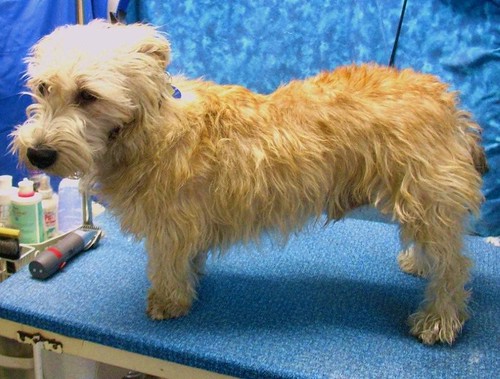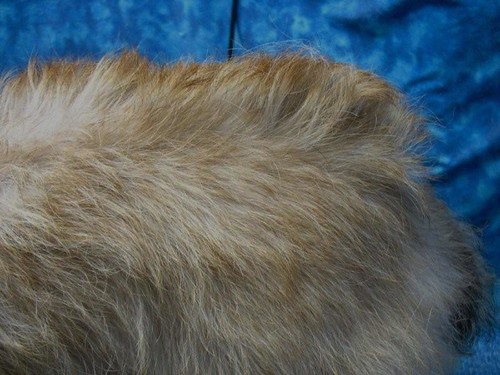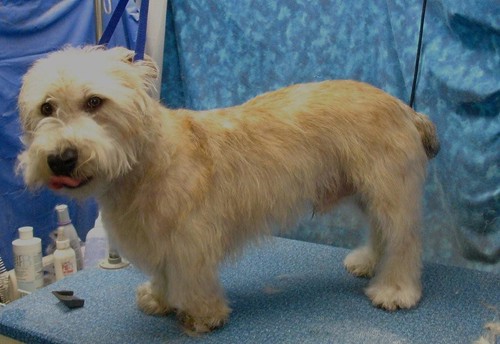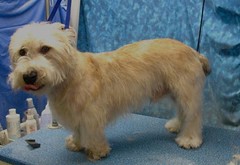First, let's review the reasons for hand stripping. Harsh coated terriers, such as Airedale, Wire Fox, Irish, Norwich, Norfolk, Cairn, West Highland (Westie), Scottish, and Welsh Terriers have double coats. Each hair follicle supports a single hard outer hair and several soft finer hairs that form the supportive undercoat. The characteristic rich color and hard texture is formed by the outer hairs. As these hairs grow out and become old, they become thin, soft and faded at the roots. More of the softer hairs push their way out of the hair follicle. The purpose of hand stripping is to remove the old faded hairs so that new growth can occur, and to muck out excess fuzzy undergrowth that may be jamming the hair follicle.
When the coat is not refreshed by stripping out the old, several things can happen: The coat can lose color and become faded, the ratio of fuzzy stuff to hard hair can be altered so that texture is lost, and the hair follicles can become plugged up with fine hairs and oily sebum. This can even lead to skin problems, such as the pimples or "acne" that is sometimes found on Miniature Schnauzers. If the hair is clipped or cut rather than pulled out, the growth of harsh new coat is inhibited, and the entire coat can become faded and soft. In some breeds, such as Airedales, the once black jacket becomes grizzled colored or greyish, the red brown becomes light brown and the leg furnishings become straw colored.
This is Finnegan, a Glen of Imaal Terrier whose body coat (called the "jacket") is very overgrown and ready for some major stripping.

If I lift and separate a section of this coat, you can see how it is nearly white at the roots. In fact, all the color is on the outer inch and a half of the hairs.
 If we were to cut of the ends of this coat, or clip it, Finnegan would become a beige boy, instead of having his nice color.
If we were to cut of the ends of this coat, or clip it, Finnegan would become a beige boy, instead of having his nice color.MORE DIFFERENCES BETWEEN CLIPPING AND HAND STRIPPING
- Hand stripping requires considerably more time than grooming with clippers. This means it will cost a lot more to have it done professionally. This is also a reason that many professional groomers decline to offer the service. Hand stripping is a very specialized service that does not fit well with a high volume grooming operation. Hand stripping is very picky work! :-)
- The end result of hand stripping requires hair growth. Although a hand stripped grooming can include considerable "tidying up" of the overall appearance, when major work is done on any area, it may look ratty until the new growth comes in. Clipped and scissored grooming can deliver a consistent finished result; hand stripping is a work in progress.
- Results of hand stripping can vary from groom to groom. If your dog is being worked on regularly, your groomer may be prioritizing different areas on different visits. In my work, sometimes I am focusing on the jacket, other times the head needs a lot of my time, and I cannot always do everything on every visit as I can with clip/scissor work.
- Full stripping, "staging" the coat, and "rolling" the coat. A "full strip" is generally when the coat has completely grown out and the groomer takes it all off, down to the fuzzy stuff. Some groomers call this "stripping to the underwear." If the dog does not have much underwear, it can be rather bald. In 10-12 weeks the dog will look great, but walking out of the grooming establishment she can look, well, can we say "butt ugly"? "Staging" the coat is often done in preparation for a presentation on a certain date, such as a dog show or grooming competition. In this format, different parts of the coat are stripped along a schedule, so that everything is at the right length on the Big Day. "Rolling" the coat is how dogs that are being campaigned on the show circuit are groomed to maintain the desired appearance. This requires at least weekly working of the coat. That way, there is always a layer of new growth coming in. Although we often call frequent pet grooming "rolling" the coat, it is nearly impossible to keep on top of a coat with less than weekly work.

This is not exactly a "full strip", as you can see there are still quite a few light hairs that could be pulled out if we were going all the way. When Finn returns in 8 weeks, these will be removed, and he should have the beginnings of a new layer of firm, dark coat. Before I called it "good enough" on this day, the coat looked like this:

And here is Finnegan as he walked out the door. I confess that I cheated on his ears. I usually hand strip the Glen Terrier ears, but Finn's ears were looking raw from the stripping, so I elected to use the clippers. In my opinion, a little "cheating" with the use of clippers and/or thinning shears is acceptable on a pet. I also cheated on the underside of his tail where he is sensitive. Who cares? Not me. My goal as a pet groomer is to work within the time available, the individual dog's coat and tolerance, and use all my skills and tools to achieve the best possible results. Here he is:

Here's the Before/After


For me, hand stripping is a lot like gardening. I am working for what it is going to look like, as well as what it looks like today. Each "crop" of hair is a little different, and each dog has an individual pattern and rate of growth. I find it fascinating and rewarding, but it does require a little more work to get the customer's expectations lined up with how I work. I hope that this article helps both other groomers and pet owners understand the process a little better.
To book an appointment, in Tucson, Arizona, you can find me at Transformation Pet Center.
I love this blog. Such great tips, even for someone like me who enjoys grooming their dogs themselves! I recently bought a brush from you (the mars flexy-king) and I want to get your shampoo book next.
ReplyDeleteI wondered if you could tell us two things:
1.) How do you deal with static in hair?
2.) how do you dry ears efficently? (spaniel ears in particular) A human ionic dryer gets too hot above cool and takes hours and hours. It also doesn't do a great job with straightening, but I was told a HF dryer was a big no no.
Maybe if these things come up at the shop you could share? I await with bated breath.
Thanks, and keep up the great work!
Thanks, Patti, I enjoy hearing that pet owners as well as professional groomers are finding value in the GroomBlog. And thanks for leaving your questions. I hope to make the blog more interactive in the future, and the central place where I write online.
ReplyDeleteStatic electricity does become a worse problem in the winter as the air is dry, especially in our homes with hot air heating. Most spray on/leave-in conditioners contain anti-static ingredients. I lightly spritz as I'm brushing and combing. If static electricity is a problem at the grooming shop, I will sometime mist over my table with fabric softener. I don't worry if a little drifts down onto the dog. I love the Downey Lavender/Vanilla and keep some at my tub to break down suds.
Drying thick coated ears can be very trying on the patience, can't it! I've got a couple of Standard Poodles where it seems that drying the ears takes as long as drying a whole small dog! I've learned to be careful of what products I use to condition those thick ears. Some thick, rich conditioners really add drying time. Silicone-based conditioners (or adding a little silicone detangling product to your favorite conditioner will often speed up drying.
Some groomers use super absorbing towels (such as used for automobile drying)to manually remove more water than regular towels before blow drying.
In the professional setting, we use high velocity dryers to force dry as much water from the dog, including the ears. We are just more careful around the ears. Caution must be exercised to not blast into the dog's ear, and to not whip tangles into the long hair. A small but mighty dryer that is reasonably priced is the Laube Magnum Force. This is the one I recommend for home groomers. I cannot IMAGINE drying cocker ears with a hand-held dryer. YIKES!
I am looking for a groomer who knows how to strip border terriers. I live in Northern New Jersey. Any names/locations would be appreciated. My dog is 9 months old and has not been stripped yet.
ReplyDeleteThis Blog is just GREAT.
ReplyDeleteI love you for sharing your knowledge.
jetti
i live in Maplewood New Jersey and need someone to hand strip my 2 borders, any suggestions?
ReplyDeletehello! love your blog! i am a groomer in miami and we have a Glen terrier also. The owner doesnt want him cut or stripped, they just bring him in for a bath and nails... reading your blog im begining to realize his horrible skin condition must be from not hand stripping him... he has pimples all over mostly his underside in between the legs. any advice on how to help him? or only stripping him will do the truick? thank you in advance!! you are amazing!
ReplyDeleteWhile we can't say for sure that not stripping this dog is causing the skin problem, it certainly could be contributing. However, we would probably not be stripping much on the underside and between the legs, where he has the most pimples.
ReplyDeleteEven if the owners are not wanting to pluck the coat, you can talk to them about allowing you to rake out dead coat (carding)and breathe some life into the coat. What you can do is to use a fairly fine toothed comb to remove more hair.
The situation sounds icky, and it is probably related to the general humid conditions in Florida. The armpit area and inside the front legs is particularly troublesome for the Glen Terrier because of how they are built. There is a lot of rubbing and not a lot of air flow in that area. It makes for matting and irritation.
One shampoo that is good for either pimply skin or greasy skin/oily coat is DermaBenSs, by Dermapet. You can find it at kvpet.com It's not the best smelling stuff, but it helps to clear out the hair follicles and remove excessive oil from the skin and coat.
What is he best shampoo for hard coated dogs?
ReplyDeleteI have a Wheaten Terrier and have been told she should be stripped as opposed to clipped. So far your discussion has revolved around the wire-haired terriers. Since the Wheaten's seem to be a bit lighter underneath, do you recommend stripping for this breed?
ReplyDeleteThanks in advance.
The Soft Coated Wheaten Terrier is NOT a hand stripped breed. You have been misinformed. Here is a link to some excellent information about grooming this breed, at the breed club website.http://www.scwtca.org/groom/index.htm Nowhere is hand stripping mentioned. Show coats are scissor trimmed. For pets, we often use clippers and snap-on combs or large sized blades. Kerry Blue Terriers are also scissored, not stripped.
ReplyDeleteSCWT is a high-maintenance grooming breed, requiring weekly brushing and combing. Hand stripping is appropriate for harsh coats, such as Scotty, Westie, Border Terrier, Wire Fox, Norwich & Norfolk, Cairn, Irish, Airedale, Welch, Lakeland, Dandy Dinmont, Glen of Imaal. I'm probably forgetting someone.
Hi
ReplyDeleteMy friend has a border terrier who just turn 1yrs she took him to the groomer about 4 days ago and was hand striped but now he's got bumps like blisters over his back and more coming up we' er both vet nurse and never seen this after grooming before. can this be from stripping ?
Hope to hear from u pip :)
Pipin, I am so sorry that your question slipped by me for a whole month. I am not a vet, so I'm not qualified for much more than an old groomer's guess.
ReplyDeleteIt sounds as though this dog has a skin disorder called folliculitis, or inflamation of the hair follicles. I have heard of this happening associated with hand stripping when the dog is bathed with a contaminated shampoo. It can be very serious, even fatal. Shampoos can become contaminated if they are diluted and allowed to sit around for days, weeks, or months. Even undiluted products can spoil over time, especially in warm weather. So called "natural" shampoos and those using "natural" preservatives are more subject to spoiling than our traditional products.
Hand stripped dogs are particularly at risk because the hair follicles are opened up. Sometimes the skin can be somewhat raw after hand stripping, especially if the groomer is not experienced. When open follicles and/or roughed up skin meets microbes in a spoiled product, infection is likely to occur. This is what I would suspect happened in this case, but I'm not there to know.
Some groomers have a preference to use a medicated shampoo after hand stripping. But these medicated products are often our least used items, and can be bad. Once diluted, a shampoo loses all preservative value, as the preservatives are no longer sufficiently present to inhibit microbial growth. Diluted products should be dumped if not used within two days.
If you get this message, would you please give us a follow up report on the dog? Again, I sincerely apologize for my lack of attention to this important matter.
Linda posted the following question. I accidentally deleted the post...
ReplyDeleteHi I have a 4 month old red lakeland terrier I have stripped the fuffy cream fur from his back and would like to know if I should strip off all the rest to allow his dark red top coat to show or should I wait until he is older.
your advice would be much appreciated
regards Linda
Linda - my understanding is that you can go ahead and pull that fluffy stuff as soon as it is loose enough to pluck out without discomfort to the puppy. My show grooming and breeder friends say to go ahead. Good luck with your grooming adventure!
I recently adopted a 5 1/2 year old norwich terrier from a family that was no longer able to keep him. Unfortunately, they clipped him for a number of years instead of hand stripping him. I do not know how to hand strip, however, i am using a stripping tool on his coat every three days or so. Will I ever be able to get his coat back to the harsh texture that it should be?? Is using a stripping tool the same as carding?? Could this eventually bring back his appropriate coat? He is very fluffy looking and has lost all his color (which i believe he was a red). Thanks!
ReplyDeleteIf you are using the stripping tool to rake through the coat and remove fuzzy stuff, it is carding the coat. This will help some, but the entire coat needs to be replaced. This can only be accomplished by plucking out the whole coat. The carding that you are doing will bring in a new layer of hair after a period of several weeks. Then you need to start plucking, and pull out all the old hair, leaving the new. A Mars Coat King, medium, can help pull out both top coat and under coat. The more overgrown the coat, the easier it will be to pluck. It can be very challenging to turn around a coat that has been repeatedly clipped. For further conversations, please find me at www.petocracy.com, where I am a Resident Expert.
ReplyDeleteThanks for your site - most helpful! I have two Norwich (pets-not show dogs) who I have been taking to a professional groomer whose work I love but I live four hours away from her! I comb my dogs with the greyhound comb and brush their teeth. I wonder what is the hair which comes out from this grooming? Is it undercoat or harsh topcoat or both? Why doesn't this nightly combing meet their needs of stripping? I have tried stripping them myself (bought a table, arm, and two mcclellan knives) but I don't have the skill or patience. When I showed the groomer what I was doing she replied that it was called 'raking' which removed undercoat. Is that what you are calling 'carding'? This process really is an art and I'm willing to pay a pro but wish I didn't have to go SO FAR! I live on Virginia's Eastern Shore. Know anyone?
ReplyDeleteYou are removing only the loosest hair by combing. It is helpful, but it's only a fraction of what needs to come out to maintain the whole coat. You can see me hand stripping a cairn in the video at https://www.youtube.com/watch?v=yp74hwGn6PI. I think you are the same person who wrote me at Petocracy.com complimenting the video. The hair that has to come out is still imbedded, although lightly so. It is the longer hair that has become thin and faded at the skin. All that hair needs to come out. It has to be plucked out, either by fingers or using a stripping knife. It's a skill that has to be developed over time. Raking is a form of carding, they are fairly interchangeable terms. Raking, carding, combing, all helps to remove old hair and make way for the new. You need to remove at least 1/3 of the coat in order to have a new crop of hair. That 1/3 forms a new layer. Properly stripped, you would want to create about 3 different layers in the coat. One way to cheat with hand stripping is to use a medium Coat King and do a vigorous raking of the coat. Although the Coat King cuts some hair, which is undesirable, it is a compromise that is sometimes worth it. You can rake out gobs of hair with the CK, leaving an "open coat" or a more sparse top layer that is easier to pull out.
ReplyDeleteI have had two responses to my inquiry in your behalf on the Facebook Grooming page. One is Debbie Sirois at Whisker Wash Dog Grooming near Richmond. The other is Rhonda Nottingham of Wash N Wag of Culpepper.
struggling with the decision: I just adopted a mini schnauzer poodle mix who has a wirey coat. I would like to keep it that this but have no experience handing stripping. Can you suggest any links or people i can talk to about how to do about doing this with him? He doesn't mind having his hair pulled on until you get to the rear end then he gets mad. I was petting him and pulling on the hairs and a bunch came out. I would like to try and do this myself before searching for a groomer who will destroy his wirey coat.
ReplyDeleteGreat post! I've been wanted to trim my own terrier for a long time now, and will definitely try out your tips!
ReplyDelete